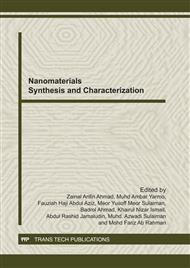p.1
p.7
p.12
p.16
p.20
p.25
p.30
p.35
p.40
Raman Spectroscopy and Field Emission Scanning Electron Microscopic Studies on Carbon Nanomaterials
Abstract:
Raman analysis is one of the main methods use to investigate type of graphitized carbon nanomaterials. It provides information on the vibration of crystal lattice, electron structure and regularity of crystal structure of the graphitized carbon materials. In this work the single step chemical vapour deposition (CVD) method was introduced for the direct growth of all as-synthesized carbon nanomaterials; carbon nanotubes (CNTs), carbon nanofiber (CNF), carbon nanosphere chain (CNSC) and CNT heterojunctions (HJCNTs). Series of metal catalysts were formulated from Ni, Fe, Cr and Cu, and were used in the synthesis of the respected carbon nanomaterials (CNMs). By introducing the right combination of the reaction conditions consisting of the formulated catalyst, reaction temperature and flow rate as well as type of carbon source resulted in the formation of different types of carbon nanomaterials. Raman spectra analysis revealed that the used of acetylene and ethanol as the carbon precursors are proficient to produce different form of carbon nanomaterials as depicted by the evolution of the G-band and D-band intensities. The FESEM micrographs obtained confirmed the morphology and types of the respected carbon nanomaterials synthesized in this study.
Info:
Periodical:
Pages:
20-24
Citation:
Online since:
October 2011
Authors:
Price:
Сopyright:
© 2012 Trans Tech Publications Ltd. All Rights Reserved
Share:
Citation:


